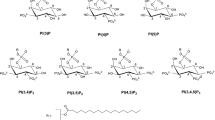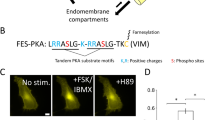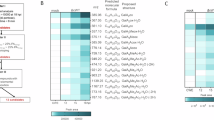Abstract
Multiple repeats of membrane occupation and recognition nexus (MORN) motifs were detected in plant phosphatidylinositl monophosphate kinase (PIPK), a key enzyme in PI-signaling pathway. Structural analysis indicates that all the MORN motifs (with varied numbers at ranges of 7-9), which shared high homologies to those of animal ones, were located at N-terminus and sequentially arranged, except those of OsPIPK1 and AtPIPK7, in which the last MORN motif was separated others by an ∼100 amino-acid “island” region, revealing the presence of two kinds of MORN arrangements in plant PIPKs. Through employing a yeast-based SMET (sequence of membrane-targeting) system, the MORN motifs were shown being able to target the fusion proteins to cell plasma membrane, which were further confirmed by expression of fused MORN-GFP proteins. Further detailed analysis via deletion studies indicated the MORN motifs in OsPIPK1, together with the 104 amino-acid “island” region are involved in the regulation of differential subcellular localization, i.e. plasma membrane or nucleus, of the fused proteins. Fat Western blot analysis of the recombinant MORN polypeptide, expressed in Escherichia coli, showed that MORN motifs could strongly bind to PA and relatively slightly to PI4P and PI(4,5)P2. These results provide informative hints on mechanisms of subcellular localization, as well as regulation of substrate binding, of plant PIPKs.
Similar content being viewed by others
Log in or create a free account to read this content
Gain free access to this article, as well as selected content from this journal and more on nature.com
or
Abbreviations
- PI:
-
(phosphatidylinositol)
- PI4P:
-
(PI 4-monophosphate)
- PI5P:
-
(PI 5-monophosphate)
- PI(4,5)P2:
-
(PI 4,5-bisphosphate)
- PIPK:
-
(phosphatidylinositol monophosphate kinase)
- PA:
-
(phosphatidic acid)
- PAGE:
-
(polyacrylamide gel electrophoresis)
References
Martin TF . Phosphoinositide lipids as signaling molecules: common themes for signal transduction, cytoskeletal regulation, and membrane trafficking. Annu Rev Cell Dev Biol 1998; 14:231–264.
D'Santos CS, Clarke JH, Divecha N . Phospholipid signalling in the nucleus. Een DAG uit het leven van de inositide signalering in de nucleus. Biochim Biophys Acta 1998; 1436:201–232.
Toker A . The synthesis and cellular roles of phosphatidylinositide synthesis. Chem Phys Lipids 1998; 98:69–77.
Martin TF . Phosphoinositides as spatial regulators of membrane traffic. Curr Opin Neurobiol 1997; 7:331–338.
Czech MP . PIP2 and PIP3: complex roles at the cell surface. Cell 2000; 100:603–606.
Hurley JH, Meyer T . Subcellular targeting by membrane lipids. Curr Opin Cell Biol 2001; 13:146–152.
Toker A, Cantley LC . Signalling through the lipid products of phosphoinositide-3-OH kinase. Nature 1997; 387:673–676.
Anderson RA, Boronenkov IV, Doughman SD, Kunz J, Loijens JC . Phosphatidylinositol phosphate kinases, a multifaceted family of signaling enzymes. J Biol Chem 1999; 274:9907–9910.
Hinchliffe KA, Ciruela A, Irvine RF . PIPkins1, their substrates and their products: new functions for old enzymes. Biochim Biophys Acta 1998; 1436:87–104.
Gary JD, Wurmser AE, Bonangelino CJ, Weisman LS, Emr SD . Fab1p is essential for PtdIns(3)P 5-kinase activity and the maintenance of vacuolar size and membrane homeostasis. J Cell Biol 1998; 143:65–79.
McEwen RK, Dove SK, Cooke FT, et al. Complementation analysis in PtdInsP kinase-deficient yeast mutants demonstrates that Schizosaccharomyces pombe and murine Fab1p homologues are phosphatidylinositol 3-phosphate 5-kinases. J Biol Chem 1999; 274:33905–33912.
Sbrissa D, Ikonomov OC, Shisheva A . PIKfyve, a mammalian ortholog of yeast Fab1p lipid kinase, synthesizes 5-phosphoinositides. Effect of insulin. J Biol Chem 1999; 274:21589–21597.
Fruman DA, Meyers RE, Cantley LC . Phosphoinositide kinases. Annu Rev Biochem 1998; 67:481–507.
Tolias KF, Cantley LC . Pathways for phosphoinositide synthesis. Chem Phys Lipids 1999; 98:69–77.
Rao VD, Misra S, Boronenkov IV, Anderson RA, Hurley JH . Structure of type IIbeta phosphatidylinositol phosphate kinase: a protein kinase fold flattened for interfacial phosphorylation. Cell 1998; 94:829–839.
Xue HW, Pical C, Brearley C, Elge S, Mueller-Roeber B . A plant 126-kDa phosphatidylinositol 4-kinase with a novel repeat structure. Cloning and functional expression in baculovirus-infected insect cells. J Biol Chem 1999; 274:5738–5745.
Hong Z, Verma DP . A phosphatidylinositol 3-kinase is induced during soybean nodule organogenesis and is associated with membrane proliferation. Proc Natl Acad Sci USA 1994; 91:9617–9621.
Welters P, Takegawa K, Emr SD, Chrispeels MJ . AtVPS34, a phosphatidylinositol 3-kinase of Arabidopsis thaliana, is an essential protein with homology to a calcium-dependent lipid binding domain. Proc Natl Acad Sci USA 1994; 91:11398–11402.
Xue HW, Hosaka K, Plesch G, Mueller-Roeber B . Cloning of Arabidopsis thaliana phosphatidylinositol synthase and functional expression in the yeast pis mutant. Plant Mol Biol 2000; 42:757–764.
Mikami K, Katagiri T, Iuchi S, Yamaguchi-Shinozaki K, Shinozaki K . A gene encoding phosphatidylinositol-4-phosphate 5-kinase is induced by water stress and abscisic acid in Arabidopsis thaliana. Plant J 1998; 15:563–568.
Shi J, Gonzales RA, Bhattacharyya MK . Characterization of a plasma membrane-associated phosphoinositide-specific phospholipase C from soybean. Plant J 1995; 8:381–390.
Hirayama T, Ohto C, Mizoguchi T, Shinozaki K . A gene encoding a phosphatidylinositol-specific phospholipase C is induced by dehydration and salt stress in Arabidopsis thaliana. Proc Natl Acad Sci USA 1995; 92:3903–3907.
Berdy SE, Kudla J, Gruissem W, Gillaspy GE . Molecular characterization of At5PTase1, an inositol phosphatase capable of terminating inositol trisphosphate signaling. Plant Physiol 2001; 126:801–810.
Lin WH, Ye R, Ma H, Xu ZH, Xue HW . DNA chip-based expression profile analysis indicates involvement of the phosphatidylinositol signaling pathway in multiple plant responses to hormone and abiotic treatments. Cell Res 2004; 14:34–45.
Stevenson-Paulik J, Odom AR, York JD . Molecular and biochemical characterization of two plant inositol polyphosphate 6-/3-/5-kinase. J Biol Chem 2002; 277:42711–42718.
Xu J, Brearley CA, Lin WH, Wang Y, Ye R, Mueller-Roeber B, Xu ZH, Xue HW . A role of Arabidopsis inositol polyphosphate kinase, AtIPK2alpha, in pollen germination and root growth. Plant Physiol 2005; 137:94–103.
Takeshima H, Komazaki S, Nishi M, Iino M, Kangawa K . Junctophilins: a novel family of junctional membrane complex proteins. Mol Cell 2000; 6:11–22.
Ma H, Xu SP, Luo D, Xu ZH, Xue HW . OsPIPK 1, a rice phosphatidylinositol monophosphate kinase, regulates rice heading by modifying the expression of floral induction genes. Plant Mol Biol 2004; 54:295–310.
Lou Y, Ma H, Lin WH, et al. The highly charged region of plant β-type phosphatidylinositol 4-kinase is involved in membrane targeting and phospholipid binding. Plant Molecular Biology 2006; in press.
Sambrook J, Russellm RW . Molecular cloning 2001: a laboratory manual, 3rd ed. Cold Spring, NY: Cold Spring Harbor Laboratory Press.
Sohlenkamp C, Wood CC, Roeb GW, Udvardi MK . Characterization of Arabidopsis AtAMT2, a high-affinity ammonium transporter of the plasma membrane. Plant Physiol 2002; 130:1788–1796.
Stevenson JM, Perera IY, Boss WF . A phosphatidylinositol 4-kinase pleckstrin homology domain that binds phosphatidylinositol 4-monophosphate. J Biol Chem 1998; 273:22761–22767.
Mueller-Roeber B, Pical C . Inositol phospholipid metabolism in Arabidopsis. Characterized and putative isoforms of inositol phospholipid kinase and phosphoinositide-specific phospholipase C. Plant Physiol 2002; 130:22–46.
Boronenkov IV, Loijens JC, Umeda M, Anderson RA . Phosphoinositide signaling pathways in nuclei are associated with nuclear speckles containing pre-mRNA processing factors. Mol Biol Cell 1998; 9:3547–3560.
Munnik, T . Phosphatidic acid: an emerging plant lipid second messenger. Trends Plant Sci 2001; 6:227–233.
Arneson LS, Kunz J, Anderson RA, Traub LM . Coupled inositide phosphorylation and phospholipase D activation initiates clathrin-coat assembly on lysosomes. J Biol Chem 1999; 274:17794–17805.
Kyte J, Doolittle RF . A simple method for displaying the hydropathic character of a protein. J Mol Biol 1982; 157:105–132.
Acknowledgements
This study was supported by Chinese Academy of Sciences and grants from National Natural Sciences Foundation of China (No. 30425029).
Author information
Authors and Affiliations
Corresponding author
Rights and permissions
About this article
Cite this article
Ma, H., Lou, Y., Lin, W. et al. MORN motifs in plant PIPKs are involved in the regulation of subcellular localization and phospholipid binding. Cell Res 16, 466–478 (2006). https://doi.org/10.1038/sj.cr.7310058
Received:
Revised:
Accepted:
Published:
Issue date:
DOI: https://doi.org/10.1038/sj.cr.7310058
Keywords
This article is cited by
-
Plasmodium pseudo-Tyrosine Kinase-like binds PP1 and SERA5 and is exported to host erythrocytes
Scientific Reports (2019)
-
A Pseudomonas T6SS effector recruits PQS-containing outer membrane vesicles for iron acquisition
Nature Communications (2017)
-
A MORN-domain protein regulates growth and seed production and enhances freezing tolerance in Arabidopsis
Plant Biotechnology Reports (2014)
-
Genetic mapping and isolation of two arc3 alleles in Arabidopsis
Plant Cell Reports (2013)
-
SAM domain-dependent activity of PfTKL3, an essential tyrosine kinase-like kinase of the human malaria parasite Plasmodium falciparum
Cellular and Molecular Life Sciences (2010)



